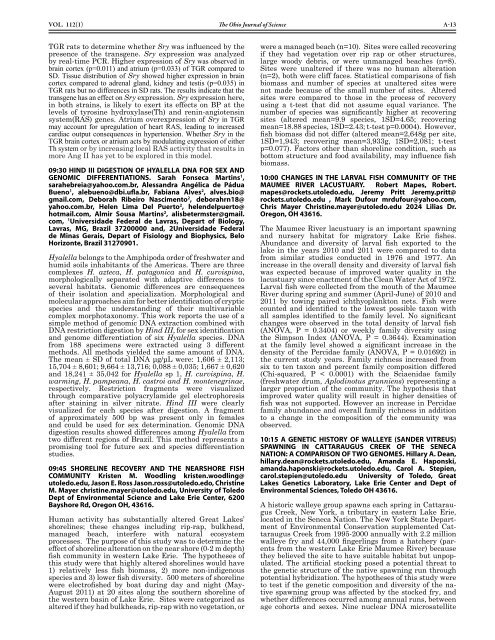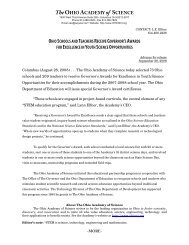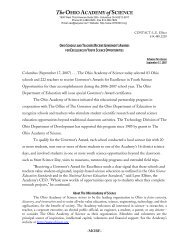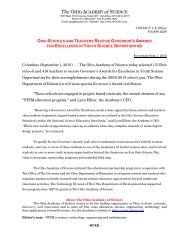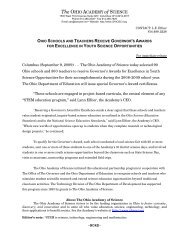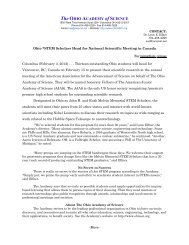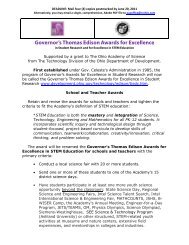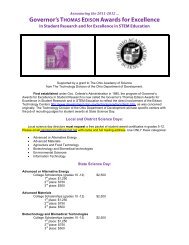The Ohio Journal of - The Ohio Academy of Science
The Ohio Journal of - The Ohio Academy of Science
The Ohio Journal of - The Ohio Academy of Science
Create successful ePaper yourself
Turn your PDF publications into a flip-book with our unique Google optimized e-Paper software.
Vol. 112(1)<br />
TGR rats to determine whether Sry was influenced by the<br />
presence <strong>of</strong> the transgene. Sry expression was analyzed<br />
by real-time PCR. Higher expression <strong>of</strong> Sry was observed in<br />
brain cortex (p=0.011) and atrium (p=0.033) <strong>of</strong> TGR compared to<br />
SD. Tissue distribution <strong>of</strong> Sry showed higher expression in brain<br />
cortex compared to adrenal gland, kidney and testis (p=0.035) in<br />
TGR rats but no differences in SD rats. <strong>The</strong> results indicate that the<br />
transgene has an effect on Sry expression. Sry expression here,<br />
in both strains, is likely to exert its effects on BP at the<br />
levels <strong>of</strong> tyrosine hydroxylase(Th) and renin-angiotensin<br />
system(RAS) genes. Atrium overexpression <strong>of</strong> Sry in TGR<br />
may account for upregulation <strong>of</strong> heart RAS, leading to increased<br />
cardiac output consequences in hypertension. Whether Sry in the<br />
TGR brain cortex or atrium acts by modulating expression <strong>of</strong> either<br />
Th system or by increasing local RAS activity that results in<br />
more Ang II has yet to be explored in this model.<br />
09:30 HIND III DIGESTION OF HYALELLA DNA FOR SEX AND<br />
GENOMIC DIFFERENTIATIONS. Sarah Fonseca Martins 1 ,<br />
sarahebreia@yahoo.com.br, Alessandra Angélica de Pádua<br />
Bueno 1 , alebueno@dbi.ufla.br, Fabiana Alves 2 , alves.bio@<br />
gmail.com, Deborah Ribeiro Nascimento 2 , deborahrn18@<br />
yahoo.com.br, Helen Lima Del Puerto 2 , helendelpuerto@<br />
hotmail.com, Almir Sousa Martins 2 , alisbetermster@gmail.<br />
com, 1 Universidade Federal de Lavras, Depart <strong>of</strong> Biology,<br />
Lavras, MG, Brazil 37200000 and, 2Universidade Federal<br />
de Minas Gerais, Depart <strong>of</strong> Fisiology and Biophysics, Belo<br />
Horizonte, Brazil 31270901.<br />
Hyalella belongs to the Amphipoda order <strong>of</strong> freshwater and<br />
humid soils inhabitants <strong>of</strong> the Americas. <strong>The</strong>re are three<br />
complexes H. azteca, H. patagonica and H. curvispina,<br />
morphologically separated with adaptive differences to<br />
several habitats. Genomic differences are consequences<br />
<strong>of</strong> their isolation and specialization. Morphological and<br />
molecular approaches aim for better identification <strong>of</strong> cryptic<br />
species and the understanding <strong>of</strong> their multivariable<br />
complex morphotaxonomy. This work reports the use <strong>of</strong> a<br />
simple method <strong>of</strong> genomic DNA extraction combined with<br />
DNA restriction digestion by Hind III, for sex identification<br />
and genome differentiation <strong>of</strong> six Hyalella species. DNA<br />
from 188 specimens were extracted using 3 different<br />
methods. All methods yielded the same amount <strong>of</strong> DNA.<br />
<strong>The</strong> mean ± SD <strong>of</strong> total DNA μg/μL were: 1,606 ± 2,113;<br />
15,704 ± 8,601; 9,664 ± 13,716; 0,088 ± 0,035; 1,667 ± 0,620<br />
and 18,241 ± 35,042 for Hyalella sp 1, H. curvispina, H.<br />
warming, H. pampeana, H. castroi and H. montenegrinae,<br />
respectively. Restriction fragments were visualized<br />
through comparative polyacrylamide gel electrophoresis<br />
after staining in silver nitrate. Hind III were clearly<br />
visualized for each species after digestion. A fragment<br />
<strong>of</strong> approximately 500 bp was present only in females<br />
and could be used for sex determination. Genomic DNA<br />
digestion results showed differences among Hyalella from<br />
two different regions <strong>of</strong> Brazil. This method represents a<br />
promising tool for future sex and species differentiation<br />
studies.<br />
09:45 SHORELINE RECOVERY AND THE NEARSHORE FISH<br />
COMMUNITY Kristen M. Woodling kristen.woodling@<br />
utoledo.edu, Jason E. Ross Jason.ross@utoledo.edo, Christine<br />
M. Mayer christine.mayer@utoledo.edu, University <strong>of</strong> Toledo<br />
Dept <strong>of</strong> Environmental <strong>Science</strong> and Lake Erie Center, 6200<br />
Bayshore Rd, Oregon OH, 43616.<br />
Human activity has substantially altered Great Lakes’<br />
shorelines; these changes including rip-rap, bulkhead,<br />
managed beach, interfere with natural ecosystem<br />
processes. <strong>The</strong> purpose <strong>of</strong> this study was to determine the<br />
effect <strong>of</strong> shoreline alteration on the near shore (0-2 m depth)<br />
fish community in western Lake Erie. <strong>The</strong> hypotheses <strong>of</strong><br />
this study were that highly altered shorelines would have<br />
1) relatively less fish biomass, 2) more non-indigenous<br />
species and 3) lower fish diversity. 500 meters <strong>of</strong> shoreline<br />
were electr<strong>of</strong>ished by boat during day and night (May-<br />
August 2011) at 20 sites along the southern shoreline <strong>of</strong><br />
the western basin <strong>of</strong> Lake Erie. Sites were categorized as<br />
altered if they had bulkheads, rip-rap with no vegetation, or<br />
<strong>The</strong> <strong>Ohio</strong> <strong>Journal</strong> <strong>of</strong> <strong>Science</strong> A-13<br />
were a managed beach (n=10). Sites were called recovering<br />
if they had vegetation over rip rap or other structures,<br />
large woody debris, or were unmanaged beaches (n=8).<br />
Sites were unaltered if there was no human alteration<br />
(n=2), both were cliff faces. Statistical comparisons <strong>of</strong> fish<br />
biomass and number <strong>of</strong> species at unaltered sites were<br />
not made because <strong>of</strong> the small number <strong>of</strong> sites. Altered<br />
sites were compared to those in the process <strong>of</strong> recovery<br />
using a t-test that did not assume equal variance. <strong>The</strong><br />
number <strong>of</strong> species was significantly higher at recovering<br />
sites (altered mean=9.9 species, 1SD=4.65; recovering<br />
mean=18.88 species, 1SD=2.43; t-test p=0.0004). However,<br />
fish biomass did not differ (altered mean=2,648g per site,<br />
1SD=1,943; recovering mean=3,933g, 1SD=2,081; t-test<br />
p=0.077). Factors other than shoreline condition, such as<br />
bottom structure and food availability, may influence fish<br />
biomass.<br />
10:00 CHANGES IN THE LARVAL FISH COMMUNITY OF THE<br />
MAUMEE RIVER LACUSTUARY. Robert Mapes, Robert.<br />
mapes@rockets.utoledo.edu, Jeremy Pritt Jeremy.pritt@<br />
rockets.utoledo.edu , Mark Dufour mrdufour@yahoo.com,<br />
Chris Mayer Christine.mayer@utoledo.edu 2024 Lilias Dr.<br />
Oregon, OH 43616.<br />
<strong>The</strong> Maumee River lacustuary is an important spawning<br />
and nursery habitat for migratory Lake Erie fishes.<br />
Abundance and diversity <strong>of</strong> larval fish exported to the<br />
lake in the years 2010 and 2011 were compared to data<br />
from similar studies conducted in 1976 and 1977. An<br />
increase in the overall density and diversity <strong>of</strong> larval fish<br />
was expected because <strong>of</strong> improved water quality in the<br />
lacustuary since enactment <strong>of</strong> the Clean Water Act <strong>of</strong> 1972.<br />
Larval fish were collected from the mouth <strong>of</strong> the Maumee<br />
River during spring and summer (April-June) <strong>of</strong> 2010 and<br />
2011 by towing paired ichthyoplankton nets. Fish were<br />
counted and identified to the lowest possible taxon with<br />
all samples identified to the family level. No significant<br />
changes were observed in the total density <strong>of</strong> larval fish<br />
(ANOVA, P = 0.3404) or weekly family diversity using<br />
the Simpson Index (ANOVA, P = 0.3644). Examination<br />
at the family level showed a significant increase in the<br />
density <strong>of</strong> the Percidae family (ANOVA, P = 0.01692) in<br />
the current study years. Family richness increased from<br />
six to ten taxon and percent family composition differed<br />
(Chi-squared, P < 0.0001) with the Sciaenidae family<br />
(freshwater drum, Aplodinotus grunniens) representing a<br />
larger proportion <strong>of</strong> the community. <strong>The</strong> hypothesis that<br />
improved water quality will result in higher densities <strong>of</strong><br />
fish was not supported. However an increase in Percidae<br />
family abundance and overall family richness in addition<br />
to a change in the composition <strong>of</strong> the community was<br />
observed.<br />
10:15 A GENETIC HISTORY OF WALLEYE (SANDER VITREUS)<br />
SPAWNING IN CATTARAUGUS CREEK OF THE SENECA<br />
NATION: A COMPARISON OF TWO GENOMES. Hillary A. Dean,<br />
hillary.dean@rockets.utoledo.edu, Amanda E. Haponski,<br />
amanda.haponski@rockets.utoledo.edu, Carol A. Stepien,<br />
carol.stepien@utoledo.edu University <strong>of</strong> Toledo, Great<br />
Lakes Genetics Laboratory, Lake Erie Center and Dept <strong>of</strong><br />
Environmental <strong>Science</strong>s, Toledo OH 43616.<br />
A historic walleye group spawns each spring in Cattaraugus<br />
Creek, New York, a tributary in eastern Lake Erie,<br />
located in the Seneca Nation. <strong>The</strong> New York State Department<br />
<strong>of</strong> Environmental Conservation supplemented Cattaraugus<br />
Creek from 1995-2000 annually with 2.2 million<br />
walleye fry and 44,000 fingerlings from a hatchery (parents<br />
from the western Lake Erie Maumee River) because<br />
they believed the site to have suitable habitat but unpopulated.<br />
<strong>The</strong> artificial stocking posed a potential threat to<br />
the genetic structure <strong>of</strong> the native spawning run through<br />
potential hybridization. <strong>The</strong> hypotheses <strong>of</strong> this study were<br />
to test if the genetic composition and diversity <strong>of</strong> the native<br />
spawning group was affected by the stocked fry, and<br />
whether differences occurred among annual runs, between<br />
age cohorts and sexes. Nine nuclear DNA microsatellite


